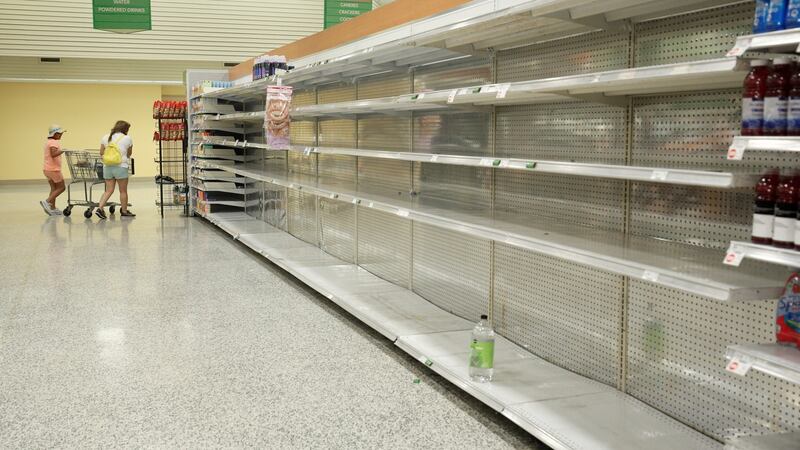Packing 210km/ph winds, Hurricane Irma knocked out electricity to more than 1 million Florida homes and businesses on Sunday as it headed towards the state’s Gulf Coast, threatening potentially catastrophic flooding.
After wreaking havoc in the Caribbean, the deadly storm was located about 125 km south-southeast of Naples on a course for the state’s western coast. Storm surges, water driven ashore by the winds, of up to 4.6 m were possible, according to the National Hurricane Center.

The new path forged by Hurricane Irma posed a severe threat to Florida’s west coast and the Florida Keys, the head of the US federal emergency agency said on Sunday, and the storm was bringing tornado watches and warnings around the state.
“This is a worst case scenario for Monroe County, the Florida Keys and the west coast of Florida,” Brock Long, administrator of the Federal Emergency Management Agency, told the Fox News Sunday program.
“Any time you’re in that northeast quadrant as the storm is moving forward, that’s where the maximum radius winds are that define the intensity of the storm,” he said. “That’s where the storm surge is most prevalent and the inland winds are going to be tough.”
The storm gained strength as it travelled over warm water between Cuba and Florida overnight, with the eyewall of the storm reaching the southern keys - a chain of small islands on the southern tip of Florida - at approximately 7am local time.
The storm has also changed its trajectory slightly north east, potentially increasing the risk to Miami, Fort Lauderdale and Palm Beach on the east coast of the peninsula.
A powerful sea surge will accompany Hurricane Irma as the storm moves through Florida, and that blast of ocean water could badly damage coastal areas, Florida Governor Rick Scott said.
“I am very concerned about the west coast,” Mr Scott said of Florida’s western shoreline that faces the Gulf of Mexico and is being hit hard by Irma.
“This storm surge is just deadly.”
On the state’s east coast, Miami was already experiencing hurricane-like conditions and heavy rain overnight with the outer sweep of the storm hitting the area.
The mayor of Miami Beach, Philip Levine, said the area is particularly concerned with tidal surges.
“The storm is so massive, it’s so huge it doesn’t make a difference if the actual core centre doesn’t go over Miami, Miami Beach. We are still receiving and going to be receiving hurricane force winds and of course we are very concerned about the tidal surges” he told NBC this morning.
A tornado warning is in effect for areas of Miami and the Miami Beach area.
Storm surges of up to 4.5m are expected in some parts of the state as the hurricane draws closer, with Florida expected to receive between 20 and 40cm of rain. More than 6 million people have been ordered to evacuate the area.
Florida governor Rick Scott warned residents that the storm will cause “life-threatening surges.”
“This will cover your house,” Mr Scott said. “You will not survive all this storm surge.”
Irma was upgraded back to a category four storm overnight as it left Cuba. The island has been left devastated by the hurricane that skimmed its northern shoreline, the centre of the island’s tourism industry. Havana has been flooded and at least 5000 tourists evacuated.
US president Donald Trump who is at Camp David for the weekend hosted a cabinet meeting yesterday and is due to be briefed on the hurricane and rescue efforts on Sunday morning.
More than a million people have lost power, with millions more homes expected to be eventually without power, potentially for weeks and months.
Irma comes just days after Hurricane Harvey dumped record-setting rain in Texas, causing one of the costliest natural disasters in US history.
Tracking models showed Irma would make landfall on the western side of the Florida peninsula and head up the west coast, bringing 190km per hour wind gusts to the state that is a major tourism hub, with an economy that comprises about five per cent of US gross domestic product.
More than 2,000 flights in and out of Florida were canceled on Saturday, according to tracking service FlightAware.com, and ground transport was scrambled by millions fleeing for safety.
Amid urgent warnings from state officials to evacuate before it was too late, downtown Miami was all but abandoned on Saturday.
Sheets of rain and wind gusts of more than 80 kmh swept through the deserted city of 400,000 people several hours before expected landfall.
The wind sent a construction crane spinning on the roof of the Miami Worldcenter, a billion dollar mixed-use project near the home of the Miami Heat basketball team and the city’s performing arts center.
On Florida’s west coast, resident Charley Ball said he expected a storm surge to completely engulf the island of Sanibel where he lives.
“Just left the island and said goodbye to everything I own,” said Ball, 62.
Irma was a Category five storm, the highest ranking possible, when it crashed into Cuba on Saturday morning.
It gradually weakened to Category 3 as it bumped along the island’s northern coastline, flooding streets and sending waves crashing over sea walls. But it is expected to gain strength over warm waters as it heads toward Florida, the NHC said.
Irma was forecast to dump up to 50 cm of rain over Florida and southeast Georgia through Monday, less than the 125 cm Hurricane Harvey dropped on parts of Texas and Louisiana two weeks ago, killing at least 60 people and causing an estimated $180 billion in property damage.
Irma could cause insurance losses of between $15 billion and $50 billion in the United States, catastrophe modeling firm AIR Worldwide said.
But unlike with Harvey, dangerous winds will barely abate once Irma makes landfall on Sunday morning.
In Cuba, the destruction along the north central coast was similar to that suffered by other Caribbean islands over the last week as Irma plowed into Ciego de Avila province.
People walked through ankle-deep water in Caibarien, a fishing town where streets were flooded and covered in seaweed. Elsewhere, winds toppled trees and utility polls or ripped apart roofs.
It was the first time the eye of a Category 5 storm had made landfall in Cuba since 1932, state media said, and the island’s Communist government ordered the evacuation of more than a million people from its path.

Officials in Florida have ordered a total of 6.3 million people, or about a third of the state’s population, to evacuate, creating massive traffic jams on highways and overcrowding shelters.
In Palm Beach, President Donald Trump’s waterfront Mar-a-Lago estate was under evacuation order.
“This is a storm of enormous destructive power, and I ask everyone in the storm’s path to heed ALL instructions from government officials,” Trump said on Twitter.
The window for people to leave evacuation zones was rapidly closing on Saturday, officials said, warning that gas stations would soon be without fuel and bridges would be closed in some areas.
Chris Cardona and his wife Laurie left their mobile home near Miami on Thursday to seek refuge with friends near Tampa.
“Not only did we go west, but so did Irma. She’s tracking us, that feisty minx,” Cardona, 54, said by phone.
Additional reporting: Reuters









